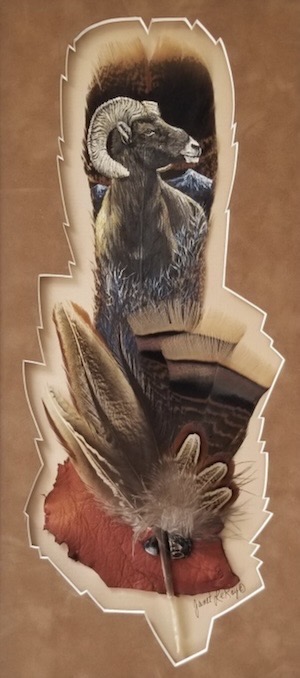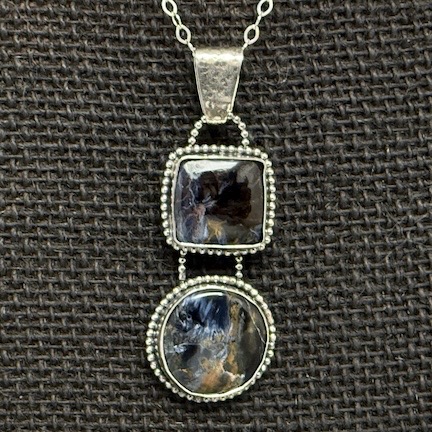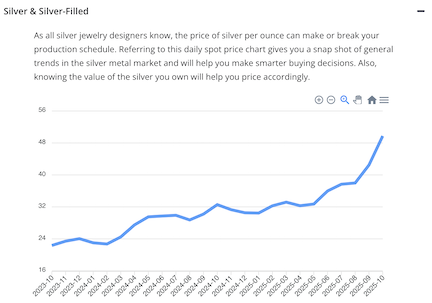You also have to jump through hoops to sell it and account for it.
When was the last time you bought something from the person who made it? A piece of pottery, a wooden jewelry box, a framed painting, a hand-bound notebook, a leather wallet, a pair of earrings?
Do you have any idea what went into that item, from the moment it was imagined by the artist to the moment you took possession of it?

My friend Janet LeRoy has been painting mostly wildlife on turkey feathers for longer than the 30 years I’ve known her. When people ask her how long it takes to do a photo, she tells them 40 years — that’s the amount of time it has taken her to hone her craft to where she is today.
Let’s look at the skills required, which is probably the least considered piece of this puzzle. Babies don’t emerge from the womb knowing how to make things. Their ability to creatively design and then construct a piece of art is something learned over years. Sure, some of it might be natural — lots of people (but not me) seem to have an eye for drawing or making music. But most folks, no matter what their natural skills seem to be, need training and practice to hone those skills. A kid has to come a long way from drawing with crayons in kindergarten to painting fine art images with acrylics on turkey feathers.
The next time you browse an art show, take a moment to consider the kinds of skills the artist needed to hone to make what you see in her booth. Think about how she got them. Maybe it’s self-taught with years and years of practice. Or maybe she took often expensive hands-on classes. (I did a bit of both.)
Now consider the often specialized tools and equipment. I bet you can’t even imagine half the tools a potter or a woodworker or a jewelry artist uses to make their artwork. Next time you’re at an art show, if an artist you admire isn’t too busy, take a moment to learn more about the tools and equipment they use in their studio.

Two color-matched Pietersite stones double bezel set in sterling silver. I made everything in this photo except the stones. (I’d rather make jewelry than polish stones.) You can find my work in my online shop.
Here’s a photo of a pendant I finished yesterday, and here’s a run-down of the tools and equipment I used to make it:
- Jeweler’s bench (homemade)
- Adjustable jeweler’s stool
- Cutting mat
- Metal shear (tabletop)
- Metal sheer (handtool)
- Steel hammer
- Weighted nylon-head mallet
- STERLING stamp
- Custom Makers mark stamp
- Flush cutters
- Flex shaft (basically a foot-controlled Dremel)
- Sanding wheel
- Bail template
- Bail-making plyers
- Chain nose pliers
- Smith Little Torch setup
- Propane Tank
- Oxygen Tank
- Quenching bowl
- Pickle pot
- Neutralizing solution
- Silver patina
- Tumbler with ceramic media
- Tumbler with steel shot
- Strainers (two meshes)
- Bezel setter
All together, this is about $2,000 worth of equipment. And it doesn’t include the the thousands of dollars of other equipment I use in other work. Not only did I have to acquire all of these tools, but I had to learn how to use them properly. (I’m still working on the Smith Little Torch.)

Rio Grande, my jewelry supply provider, keeps up-to-date pricing information for all precious metals right on its website.
And then there are the materials. I had sticker shock this morning when I checked the price of sterling silver; it’s up more than 100% in two years. Thank heaven I stocked up earlier this year and have enough to take me through the winter. I’ll need to have a few good shows before I stock up again. I’m fortunate that I now have enough cabochons in my collection to last the rest of my life. (Buying stones is a bit of an addiction for me.)
Now I’m getting into monetary costs and I really didn’t mean to go there. So let’s take a turn back to what prompted me to write this post: updating my jewelry business online shop.
The point is, it’s not enough to be creative and have the skills and tools and materials to turn ideas into a piece of art. Today’s artists need to be able to sell that art to keep making it. And that means they’re usually in charge of marketing and sales — after all, how many artists can afford to hire someone to handle that for them?
Marketing, to me, means mentioning my work on social media, trying (and mostly failing) to keep a website up-to-date, photographing all my new work. I’m lucky (or stupid) because I’m only on one social media platform — Mastodon — so I’m not dealing with Twitter, Facebook, Instagram, or Tik Tok. (I occasionally put videos on YouTube, but since losing my login information for my jewelry account, that’s been a bit difficult.) I simply can’t see spending hours of every day promoting my work on social media when I should be making the work I have to promote.
Sales means applying to and then attending often costly art shows with setup and teardown that suck the physical life out of me. Even just sitting in my booth all day, eating snacks out of a little cooler and having to rely on other artists to keep an eye on things when I run to the restroom to take a leak can be exhausting. Heck, when I do the Leavenworth WA show some weekends, my day is 11 to 14 hours (long door to door), depending on whether it’s a setup day. The show I’m attending in Seattle soon is costing me more than $800 for a 10 x 6 foot space; do you know how much jewelry I have to sell to cover that? (At least it’s indoors.)
Sales also means updating an online shop. I know a lot of folks use Etsy and depend on it for sales. I don’t. I’m tired of them taking such a large chunk of my revenue and displaying my work among so much cheap crap. I’m tired of having to maintain two inventory systems that I have to manually sync up when I make or sell something. I’m tired of giving money to an organization that misleads buyers and sellers. And when you shop there, have you ever stopped to consider how much sellers have to jack up their prices to make a profit after Etsy takes its fees?
So I have my own Square-based shop. It’s free to set up and use; the only fee is the standard credit card fee I pay when a sale is made. But it still takes time to update the site with photos and descriptions when I make new items or sell items outside the square system.
Did I mention that I have to be a photographer, too? Yep. I have to take decent photos of all of my work. I do the best I can, but I’m not pretending it’s good. It’s passable. (Yesterday I considered hiring someone to do it. But I quickly realized I didn’t have the budget to pay someone else to do it.)
And did I mention that I also have to account for all my sales? And file sales tax returns for every state I sell in? So yes, I have to be an accountant, too. (Good thing I got that accounting degree back in the 1980s.)
So I guess that what I’m trying to say is that unless an artist is independently wealthy and can make art for fun, there’s a lot more to making art than just making art.
Think about that the next time you see original artwork available for sale.
Discover more from An Eclectic Mind
Subscribe to get the latest posts sent to your email.

I’m familiar with your excellent jewellery but the work of Janet Le Roy is new to me. Outstandingly beautiful.
She is right, artistic skills need commitment and motivation to acquire but they are refined by practice and creative development. It is a long slow road but always worth the effort.
Janet’s work is amazing and even better in person than in photos. (Isn’t that usually the way?) I am proud to own two originals that she painted just for me and one of her prints. With luck, we’ll be traveling together in Arizona for a while. We both applied to three shows. I’m sure she’ll get into all of them; so far, I’ve been accepted to one but should know next week about the other two.
The trouble with art shows — especially the low-end ones — is that people are always trying to calculate your profit on your work. So they see an original painting that she’s selling for $495 and think well, if she painted that in a few hours, she’s really cleaning up! But that goes back to my blog post — no one really thinks about what an artist has to do and know and have to make and sell art. I don’t mind making art, but the marketing, selling, and accounting for it is extremely tiresome.